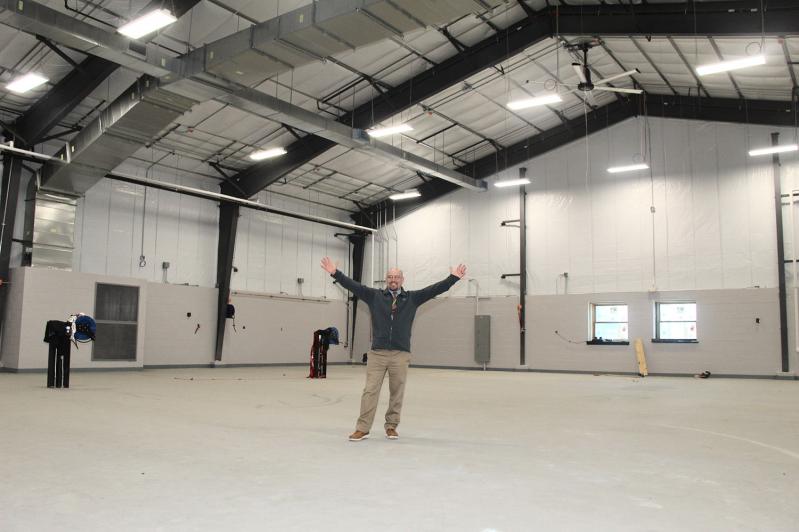The East Hampton School District’s new transportation center on Springs-Fireplace Road is proof that the future of school busing here is much more than bright yellow buses and a place to park them.
The new facility is more than double the size of the district’s previous bus depot, which was on a heavily trafficked stretch of Route 114 that cost, starting in 2006, around $200,000 a year to rent. The 10,688-square-foot “bus barn,” as school officials call it, could include a number of amenities for the drivers — a gym, a lunchroom, nice bathrooms and lockers, a quiet space for relaxation, a safer facility over all — that are expected to help attract and retain employees amid an ongoing national shortage of school bus drivers.
There will also be state-of-the-art repair and inspection bays, charging stations for electric buses when the district eventually upgrades the fleet, and an automotive technology classroom to prepare students for future careers in the industry.
The project has the potential to save the district money, as it will no longer have to pay rising rents on its current bus barn. It decreases the amount of time and money spent sending students to BOCES programs in Riverhead and farther west, and has the potential as well for shared services with other school districts.
“Everybody’s very excited about it. The new facility, as far as morale goes, and people looking forward to going to work in the morning, will make a major difference,” Joe Lipani, who has been East Hampton’s head bus driver and mechanic since 2013, said by phone this week.
The district is still short on drivers, he said, but “I think it will be a better hiring point that we have these amenities for people, instead of just sitting in the cold with your car running.”
The current facility has 28 drivers and three mechanics sharing one bathroom, a small break room, and a makeshift gym, consisting of equipment discarded by the athletics program packed into a storeroom. The parking area for 35 buses was so tight that “you practically can’t slide a piece of paper between them. They’re six deep, with one person parking buses,” said J.P. Foster, president of the East Hampton School Board. “It was not an efficient operation, and it was just not big enough, building-wise or parking-wise.”
The new facility could be ready for occupancy as soon as late April or May, depending on whether parts and equipment are delayed by the continuing nationwide supply-chain problem.
At the bus barn on Monday, Adam Fine, the district superintendent, Sara Smith, the high school principal, and Tom Zarcone, who represents the architect, Mike Guido, showed some visitors around the cavernous space. “You know who should really be here? Rich Burns,” Mr. Fine said, crediting much of the transportation center’s success to his predecessor as superintendent.
The State Education Department has already approved the automotive technology class’s curriculum, a process that was spearheaded by Cathy Tyree, a business teacher who oversees East Hampton’s career education programs. In building the curriculum, Erick Bock, a local mechanic, helped the district fine-tune the proposal and decide what equipment to order, and school officials visited the auto shop at William Floyd High School, which is known for its robust vocational education classes.
One major challenge will be hiring the right teacher for the career-prep program, Mr. Fine said. “We’re really trying to hire someone from the field,” he said. The position will be part time to begin with, and will include benefits, but will shift to full time when the program fully ramps up.
Ms. Smith said the class has generated buzz among students as guidance counselors spread the word. “We’re so excited,” she said.
The auto shop program at the bus barn, much closer to the high school than BOCES technical programs west of here, means students won’t have to spend two to three hours traveling to class every day. That will allow them to take a more diverse array of courses and participate in sports and after-school activities, Ms. Smith said. “You can still take Advanced Placement courses or electives. It allows more flexibility in the schedule.”
A project at least eight years in the making — nearly the entire time Mr. Foster has served on the school board — the new facility initially attracted “pitchforks and torches” when the district considered building it on its own campus off Cedar Street. Critical neighbors ultimately banded together and helped the district secure the former East Hampton Town scavenger waste property, which had lain vacant for several years. In May 2018, voters approved a bond referendum for $8.9 million, including $2.3 million for the land and $6.6 million for construction and equipment. Construction officially kicked off in February 2021.
“Without a doubt,” said Mr. Foster, “it’s money well spent.”

